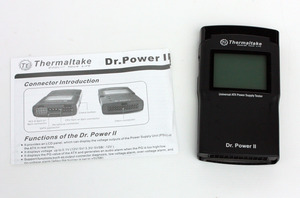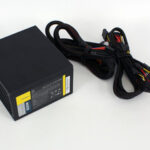The Thermaltake Dr. Power II PSU tester checks computer power supply output with the ease of a fully automated handheld tester to show voltages and the Power Good value with a fault mode including visual and audio warnings.
Ease of Use, Performance: 23/25
Look & Feel: 24/25
Features 21/25
How much I enjoy 22/25
Total: 90/100
Thermaltake has rebuilt from the ground up their power supply tester with a new LCD readout, more plug configurations and a new diagnostic system. The Dr. Power II has been built with current computers in mind and uses the standard connectors common to today’s supplies for connecting.
The Dr. Power II has a front LCD screen for reading voltages and error messages while the bottom and top of the handheld tester has the power connections. The top has the 4 pin Molex, SATA, 4 or 8 pin CPU and 6 or 8 pin PCI-E connections while the bottom has the 24 pin motherboard connection.
There is a power button on the side that also selects the various tests to move from one to the next when you want to manually select different tests. The Dr. Power II has two modes allowing you to manually switch from each test using the power button or an automatic mode where the tester moves along testing each connection every five seconds.
The tester checks the 5 volt and -5 volt, 12 volt and -12 volt, 3.3 volt and 5 volt Vsb voltages along with the Power Good timing. The PG or Power Good value is the delay that the power supply has before it is fully ready to send the proper voltages to the rest of your computer.
This delay needs to be within a certain time frame, 100 milliseconds to 500 milliseconds, in order for the power supply to register as good by the tester. When any voltages are high or low or the Power Good value is out of specification the tester will go into fail mode and the screen turns red.
The tester will also buzz to let you know something is wrong and you need to do something before trying to use the power supply on a computer. You can see the fault detection when you turn off your power supply using the power switch on the supply for a second or so.
You test your power supply by connecting the tester to at least the main 24 pin cable from the power supply and supplying the PSU with power. The other connections like the CPU and drive cables can be tested one at a time to ensure the cables are good as well as the PSU is supplying power at the proper voltage.
I have an older power supply and rigged it to fail in a few different ways and the tester had no problems detecting the drop and going into failed mode. The tester displayed the low voltage, showed the red background while buzzing so I knew it was a problem and easily saw by the readout that the five volts was too low.
The tester is easy to use and works well for finding out if you have a problem with the most often overlooked part of a computer, the power supply. If you are a computer enthusiast and build computers a power supply tester is a must have device and will easily show if your PSU is having problems.
The Thermaltake Dr. Power II is a handy device and so easy to use that you really do not have to read the instructions but it is helpful to learn about all the functions and features. I highly recommend the Thermaltake Dr. Power II power supply tester that costs about $40 and is available at online sites including Amazon.
Dr. Power II @ Thermaltake







